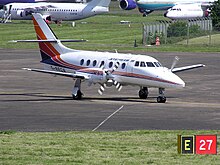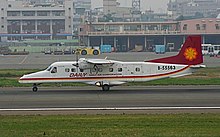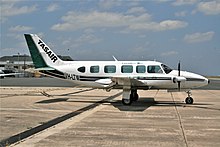Feeder aircraft

A commuter aircraft ( English Commuter Aircraft or feeder liner ) is a smaller short-range - airliner for more than 19 passengers and maximum take-off weight ( MTOM ) of 8,618 kg (19,000 lbs ). Internationally, however, some types with larger capacity and take-off mass are also used in this role. In the same way, smaller machines are occasionally used as feeder aircraft, which, depending on the type, only have 6 to 10 seats.
The next larger class of commercial aircraft for use on short-haul routes is called regional commercial aircraft or regional aircraft .
history

The need for aircraft specially designed for feeder services was formulated as early as 1943 during the Second World War by the Brabazon Commission in Great Britain , which called this type of feederliner (English feeder = "Einspeiser" or "Beschicker"). Some types such as the De Havilland DH.104 Dove and Handley Page Marathon (originally Miles M.60 Marathon ) were developed, but later only the former was successful.
This airliner type witnessed only in the 1950 's in the United States the first real major use in commercial aviation. The four-engine De Havilland DH.114 Heron , which was developed from the DH.104 Dove and made its first flight in 1950 and was used in 30 countries, is considered to be one of the first specially designed aircraft for use as a feeder around the world . The Heron was also flown in Europe, the USA and Canada as well as Australia and formed the basis for some modernizations on its base. Another machine developed especially for this purpose in the late 1960s and known not only in North America is the Fairchild Swearingen Metro .
New specific requirements for feeder aircraft emerged again in the USA in the 1970s , when the hub and spoke structure with hubs or nodes became established in commercial aviation. To oscillate (English commute ) between smaller end node and the central node are short-haul aircraft required for approximately 15 passengers.
As a result, aviation authorities such as the US Federal Aviation Administration (FAA) developed approval regulations that were adapted for this aircraft class. For example, EASA's certification specification CS-23 (Certification Specifications) deals with Normal, Utility, Aerobatic and Commuter aircraft with a maximum of 19 seats (without crew ) and a maximum take-off weight ( MTOW ) of 8,618 kg (19,000 lbs ).
Worldwide, however, larger aircraft with around 30 seats and thus more capacity or smaller aircraft are used as feeder aircraft, which, depending on the type, only have 6 to 10 seats.
Well-known types

Used types
- Antonov An-14 Ptschjolka
- Antonov An-28
- BAe Jetstream
- Beechcraft 99
- Beechcraft 1900
- Britten-Norman Islander
- Britten-Norman Trislander
- Cessna 208 Grand Caravan
- Cessna 402
- Cessna 404 titanium
- De Havilland Canada DHC-6 Twin Otter
- Dornier Do 228
- Embraer EMB 110 Bandeirante
- Fairchild Swearingen Metro
- GAF Nomad
- Gippsland GA-8 Airvan
- Handley Page Jetstream
- Harbin Y-12
- Let L-410 Turbolet
- NAL Saras
- Piper PA-31 Navajo
- Reims-Cessna F406
- Short SC.7 Skyvan
- Tecnam P2012 Traveler
Historical types
- De Havilland DH.104 Dove
- De Havilland DH.114 Heron
- De Havilland Australia DHA-3 Drover
- Handley Page Marathon (ex Miles M.60 Marathon )
- Saunders ST-27 (turboprop conversion of the de Havilland Heron )
See also
- Commercial aircraft - of which the subspecies:
- Business jet
- List of aircraft types

